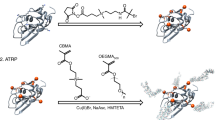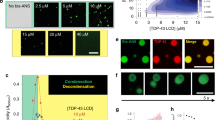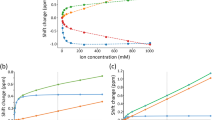Abstract
The use of cosolvents in aqueous systems has been shown to enhance protein refolding and decrease aggregation. In this study, we have used polyethylene glycol (PEG) in the molecular weight range of 1000 to 8000 Daltons to effectively increase the rate of refolding and prevent aggregation of the model protein, bovine carbonic anhydrase B (CAB). At concentrations of 3 and 30 g/1, PEG increased the rate of recovery of active protein in the absence of aggregation. Using 3 g/1 PEG (3350 MW), the refolding rate was three fold greater than the observed normal refolding rate. The observed rate enhancement was caused by PEG acting on the first intermediate in the CAB refolding pathway to increase the rate of formation of the second intermediate. The interaction of PEG with the first intermediate also prevented its self-association during refolding and at equilibrium. The stabilization of this first intermediate resulted in complete recovery of active protein under normal aggregating conditions.
This is a preview of subscription content, access via your institution
Access options
Subscribe to this journal
Receive 12 print issues and online access
$209.00 per year
only $17.42 per issue
Buy this article
- Purchase on Springer Link
- Instant access to full article PDF
Prices may be subject to local taxes which are calculated during checkout
Similar content being viewed by others
References
Marston, A.O. 1986. The purification of eukaryotic polypeptides synthesized in Escherichia coli. Biochem J. 240: 1–12.
Cleland, J.L. and Wang, D.I.C. 1990. Refolding and aggregation of bovine carbonic anhydrase B: a quasi-elastic light scattering analysis. Biochemistry. In Press.
Mitraki, A. and King, J. 1989. Protein folding intermediates and inclusion body formation. Bio/Technology 7: 690–697.
Brems, D.N. 1988. Solubility of different folding conformers of bovine growth hormone. Biochemistry 27: 4541–4546.
Cleland, J.L. and Wang, D.I.C. 1990. Equilibrium association of a molten intermediate in bovine carbonic anhydrase B refolding. In: American Chemical Society Symposium Series, G. Georgiou (Ed.). New York, NY. In Press.
Havel, H.A., Kauffman, E.W., Plaisted, S.M. and Brems, D.N. 1986. Reversible self-association of bovine growth hormone during equilibrium unfolding. Biochemistry 25: 6533–6538.
Brems, D.N., Plaisted, S.M., Kauffman, E.W. and Havel, H.A. 1986. Characterization of an associated equilibrium folding intermediate of bovine growth hormone. Biochemistry 25: 6539–6543.
Arawaka, T., Bhat, R. and Timasheff, S.N. 1990. Why preferential hydration does not always stabilize the native structure of globular proteins. Biochemistry 29: 1924–31.
Schein, C.H. 1990. Solubility as a function of protein structure and solvent components. Bio/Technology 8: 308–317.
Stein, P.J. and Henkens, R.W. 1978. Detection of intermediates in protein folding of carbonic anhydrase with fluorescence emission and polarization. J. Biol. Chem. 253: 8016–8018.
Doligh, D.A., Kolomiets, A.P., Bolotina, I.A. and Ptitsyn, O.B. 1984. ‘Molten-globule’ state accumulates in carbonic anhydrase folding. FEBS Letts. 165: 88–92.
Semisotnov, G.V., Rodionova, N.A., Kutyshenko, V.P., Ebert, B., Blanck, J. and Ptitsyn, O.B. 1987. Sequential mechanism of refolding of carbonic anhydrase B. FEBS Letts. 224: 9–13.
Ikai, A., Tanaka, S. and Noda, H. 1978. Reactivation kinetics of guanidine denatured carbonic anhydrase B. Arch. Biochem. Biophys. 190: 39–45.
Wong, K.-P. and Tanford, C. 1973. Denaturation of bovine carbonic anhydrase B by guanidine hydrochloride. J. Biol. Chem. 248: 8518–8523.
Rodionova, N.A., Semisotnov, G.V., Kutyshenko, V.P., Uverskii, V.N., Bolotina, I.A., Bychkova, V.E. and Ptitsyn, O.B. 1989. Two-stage equilibrium unfolding of carboanhydrase B by strong denaturing agents. Mol. Biol. 23: 683–692.
Arakawa, T. and Timasheff, S.N. 1985. Mechanism of poly(ethylene glycol) interaction with proteins. Biochemistry 24: 6756–6762.
Semisotnov, G.V., Uversky, V.N., Sokolovsky, I.V., Gutin, A.M., Razgulyaev, O.I. and Rodionova, N.A. 1990. Two slow stages in refolding of bovine carbonic anhydrase B are due to proline isomerization. J. Mol. Biol. 213: 561–568.
Ptitsyn, O.B., Pain, R.H., Semisotnov, G.V., Zerovnik, E. and Razgulyaev, O.L. 1990. Evidence for a molten globule state as a general intermediate in protein folding. FEBS Letts. 262: 20–24.
Proctor, Y. and Stone, J.T. 1967. The catalytic versatility of erythrocyte carbonic anhydrase. III. Kinetic studies of the enzyme-catalyzed hydrolysis of p-nitrophenyl acetate. Biochemistry 6: 668–678.
Author information
Authors and Affiliations
Rights and permissions
About this article
Cite this article
Cleland, J., Wang, D. Cosolvent Assisted Protein Refolding. Nat Biotechnol 8, 1274–1278 (1990). https://doi.org/10.1038/nbt1290-1274
Received:
Accepted:
Issue Date:
DOI: https://doi.org/10.1038/nbt1290-1274
This article is cited by
-
Cyclodextrin–protein interaction as inhibiting factor against aggregation
Journal of Thermal Analysis and Calorimetry (2017)
-
Potential application of waste from castor bean (Ricinus communis L.) for production for xylanase of interest in the industry
3 Biotech (2016)
-
PEGylation-aided refolding of globular adiponectin
World Journal of Microbiology and Biotechnology (2013)



